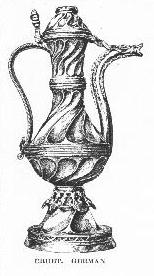|
| A B C D E F G H I J K L M N O P Q R S T U V W X Y Z |

A small vessel used for containing the wine and water required for the Holy Sacrifice of the Mass. Two are always employed. The Roman Missal (Rubricæ Gen., XX) directs that they should be made of glass. This is the most suitable material because easily cleaned, and its transparency obviates danger of confounding the water and wine. Other materials, however, are used, such as gold, silver, and other precious metals. In this case it is advisable to have a V (Vinum) on the wine and an A (aqua) on the water cruet, so that one may be easily distinguished from the other. In shape nothing is prescribed, but the vessels should have a good firm base on which to stand securely and a fairly wide neck so as to admit of being easily cleansed. They should have a cover to keep away flies and insects. Formerly the wine for the Holy Sacrifice was brought by the faithful in a jar-shaped vessel. It was then received by the deacon and poured into the chalice, a vestige of which custom is still observable at the consecration of a bishop.
APA citation. (1908). Cruet. In The Catholic Encyclopedia. New York: Robert Appleton Company. http://www.newadvent.org/cathen/04543a.htm
MLA citation. "Cruet." The Catholic Encyclopedia. Vol. 4. New York: Robert Appleton Company, 1908. <http://www.newadvent.org/cathen/04543a.htm>.
Transcription. This article was transcribed for New Advent by Marcia L. Bellafiore. Image scanned by Wm Stuart French Jr.
Ecclesiastical approbation. Nihil Obstat. Remy Lafort, Censor. Imprimatur. +John M. Farley, Archbishop of New York.
Contact information. The editor of New Advent is Kevin Knight. My email address is webmaster at newadvent.org. Regrettably, I can't reply to every letter, but I greatly appreciate your feedback — especially notifications about typographical errors and inappropriate ads.